

Bystander Effect. ILLUSTRATION: Bystander Effect. EXPERIMENT: The Bystander Effect. 10 Notorious Cases of the Bystander Effect. The bystander effect is the somewhat controversial name given to a social psychological phenomenon in cases where individuals do not offer help in an emergency situation when other people are present. The probability of help has in the past been thought to be inversely proportional to the number of bystanders. In other words, the greater the number of bystanders, the less likely it is that any one of them will help.
This list describes the prototype of the effect and cites nine particularly heinous examples. The Parable of The Good Samaritan. The 21st century bystander effect happens every day online. If you’re going to fall, injure yourself and need help, where is a good place to do it?

Should you choose a busy thoroughfare or a deserted backstreet? Statistics and experiments in social psychology will tell you that if you need help, you should avoid dropping in a busy street, even if hundreds of people are passing through. This is because of a phenomenon known as the bystander effect.
The more individuals gathered in one place, the less chance there is of one of them coming to the aid of a person in need. When an emergency situation occurs, it’s more likely that someone will come to the rescue if there are fewer or almost no witnesses. Social media, mobile phones changing 'bystander effect' If someone was in need, would you step in to help, or pull out your phone and record?

That’s the question social psychologists are trying to answer, the CBC’s Chris Brown reports. The bystander effect, a phenomenon studied fervently after the grisly 1964 New York City murder of Kitty Genovese which police initially believed was witnessed by over 30 people, is now being examined through the lens of social media. Modern Day Bystanders. Bystander Intervention in Emergencies: Diffusion of Responsibility. Bystander Intervention in Emergencies: Diffusion of Responsibility By JOHN M.

DARLEY BIBB LATANÉ Several years ago, a young woman was stabbed to death in the middle of a street in a residential section of New York City. Although such murders are not entirely routine, the incident received little public attention until several weeks later when the New York Times disclosed another side to the case: at least 38 witnesses had observed the attack–and none had even attempted to intervene. Diffusion of Responsibility. How Diffusion of Responsibility Affects Group Behavior.
Diffusion of responsibility is a psychological phenomenon in which people are less likely to take action when in the presence of a large group of people.1 For example, imagine that you are in a large city on a bustling street.
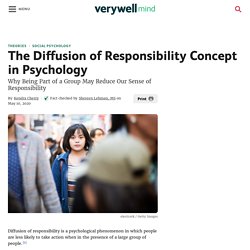
You notice a man fall to the ground and start convulsing as if having a seizure. Many people turn and look at the man, but no one moves to help or call for medical assistance. Diffusion of Responsibility: Definition and Examples in Psychology. What causes people to intervene and help others?
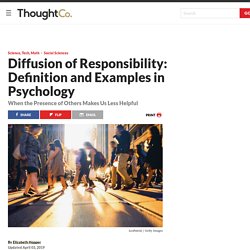
Psychologists have found that people are sometimes less likely to help out when there are others present, a phenomenon known as the bystander effect. One reason the bystander effect occurs is due to diffusion of responsibility: when others are around who could also help, people may feel less responsible for helping. Key Takeaways: Diffusion of Responsibility Diffusion of responsibility occurs when people feel less responsibility for taking action in a given situation, because there are other people who could also be responsible for taking action.In a famous study on diffusion of responsibility, people were less likely to help someone having a seizure when they believed there were others present who also could have helped.Diffusion of responsibility is especially likely to happen in relatively ambiguous situations.
Pluralistic Ignorance. Pluralistic Ignorance Definition Pluralistic ignorance occurs when people erroneously infer that they feel differently from their peers, even though they are behaving similarly.

As one example, imagine the following scenario: You are sitting in a large lecture hall listening to an especially complicated lecture. After many minutes of incomprehensible material, the lecturer pauses and asks if there are any questions. No hands go up. You look around the room. How to Overcome the Bystander Effect. Psychologists have long been interested in exactly why and when we help other people.
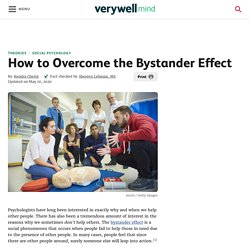
There has also been a tremendous amount of interest in the reasons why we sometimes don't help others. The bystander effect is a social phenomenon that occurs when people fail to help those in need due to the presence of other people. Five Steps to Helping Behavior. Decision Model of Helping Definition The decision model of helping, introduced in The Unresponsive Bystander by Bibb Latane and John Darley, outlines a process of five steps that will determine whether a bystander will act or not in a helping situation.
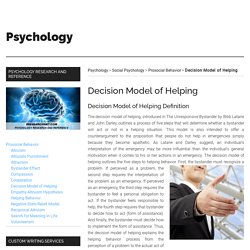
This model is also intended to offer a counterargument to the proposition that people do not help in emergencies simply because they become apathetic. Active bystander. BYSTANDER INTERVENTION. Reducing Bystander Apathy. David A.
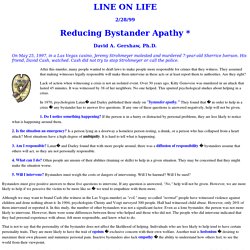
Gershaw, Ph.D. After this murder, many people wanted to draft laws to make people more responsible for crimes that they witness. They assumed that making witnesses legally responsible will make them intervene in these acts or at least report them to authorities. Are they right? The Three D’s of D.O.T Intervention: Direct, Distract, and Delegate. You may be wondering about how you can intervene if you see an incidence of violence happening or a situation has the potential for violence?

You may have concerns for your own safety and welfare or perhaps being confrontational is not part of who you are. Part of the Green Dot philosophy is teaching bystanders how to intervene in a manner that is comfortable for them.Direct: A direct intervention is exactly as it says; a bystander confronts a situation him or herself. For example, you may witness a situation developing with a friend and another person that looks like it may escalate so you step in and pull your friend out of the situation and walk him/her away. When safe, being direct is the most immediate way to intervene in a situation.Distract: Perhaps you don’t want to address a situation directly then you can try to cause a distraction that will diffuse the situation and give a moment for things to calm down.
Bystander Intervention Resources. Bystander Intervention Training Hollaback! Provides trainings on how to do your part to protect your neighbors and co-workers when bias and harassment collide in front of you. What’s worse than being targeted with harassment because of your race, sex, religion, color, gender, size, orientation, disability, age, or origin? Being targeted while surrounded by bystanders who see what is happening, but then do nothing. Bystander Intervention: The Stranger Choice One- Direct. Bystander Intervention: The Stranger Choice Two- Distract.
Bystander Intervention: The Stranger Choice Three- Delegate. You can take charge, do not assume someone else will! If you ever need help, ask for it! Be An Upstander! Cyberbystanders were generally unwilling to intervene, seeing several offenders increased their likelihood of engaging in the Bystander Intervention Model’s (BIM) stages. We use cookies to enhance your experience on our website.By continuing to use our website, you are agreeing to our use of cookies. You can change your cookie settings at any time. <a href=" Find out more</a> Skip to Main Content Search Close. From Empathy to Apathy: We do not actively choose apathy, but are merely reflexively behaving as bystanders. When people are asked whether they would spontaneously assist a person in an emergency situation, almost everyone will reply positively.
Although we all imagine ourselves heroes, the fact is that many people refrain from helping in real life, especially when we are aware that other people are present at the scene. In the late 1960s, John M. Darley and Bibb Latané (1968) initiated an extensive research program on this so-called “bystander effect.” The effect of another bystander's ability to help on bystander intervention in an emergency. Bystander Effect: Women are more helpful.
Ted Huston and his colleagues (1981) found out that helpers more often had had some medical, police, first-aid, or CPR training in dealing with emergency situations. Men and women were equally likely to report an intention to intervene, but women were most likely to help children, while men were most likely to help women.